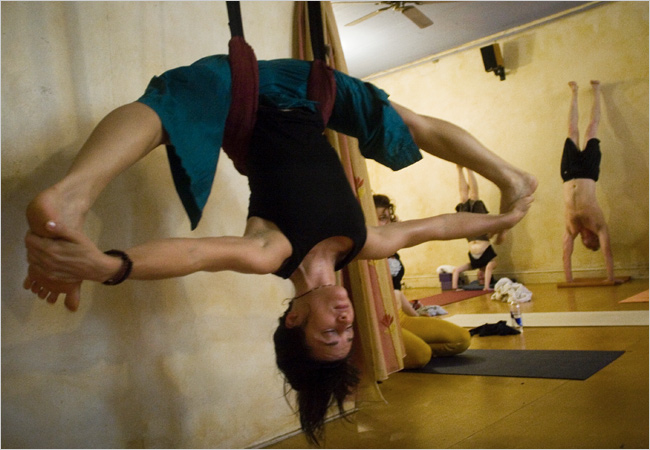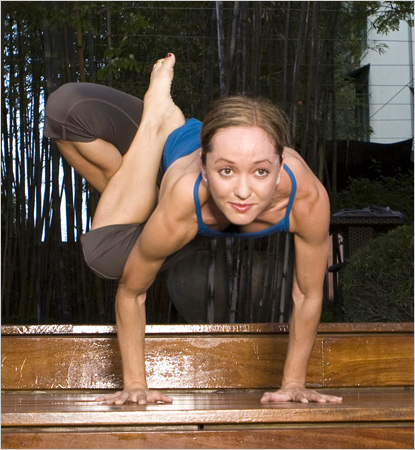AS PUBLISHED IN THE NEW YORK TIMES
When Raquel Prieto moved from Northampton, Mass., to Boston in January, there was one thing she sought as urgently as an affordable living situation and a job: an advanced yoga class.
As a dedicated yogi, she wanted to work on meditation and on poses, or asanas, requiring a lot of strength and flexibility and a deep mental focus.
Even after spending $700 and two months trying out studios, she still hadn’t found a place she could build on the advanced practice she developed in a Northampton studio. So she patched together a combination of home practice, classes at a nearby yoga center, visits to a meditation center and trips back to Northampton.
“I’m not thrilled,” said Ms. Prieto, 23. “It’s hit or miss.” Her search for satisfaction, she said, “was a huge emotional thing. I got depressed.”
With a yoga studio seemingly on every corner, it might appear counterintuitive for any yoga class to be in short supply. But Ms. Prieto’s experience is not unique; many seasoned practitioners report having a hard time finding challenging classes.
The reason is simple. Yoga has evolved from a passion for the few into a mainstream pursuit. There are 15.8 million adults practicing yoga, according to Yoga Journal’s recent “Yoga in America” study, with almost one third of them practicing for a year or less. The study also found that the number of people interested in trying yoga tripled from 2004 to 2008 to an estimated 18.3 million.
Since catering to the legions of more novice practitioners makes the most business sense, most of the classes at yoga centers are geared toward the basic and intermediate levels.
“Things have swayed backward from very advanced asana practice,” said Jasmine Tarkeshi, a director of Laughing Lotus Yoga Center, which has studios in New York and San Francisco.
Prime-time offerings must cater to the largest group of students, she added. “We have to make it accessible for everyone, especially those evening slots when most people can come.” Smaller advanced classes are typically relegated to less-desirable midday slots.
Part of the problem, say many teachers and practitioners, is a scarcity of instructors capable of guiding students into a more-advanced practice. These days, they say, many master teachers travel around the world giving workshops, another result of the profitable explosion in yoga’s popularity. Americans spend $5.7 billion a year on yoga classes, products, equipment, clothing and media, up 87 percent from 2004, the Yoga Journal study found.
While it is hard to accurately tell how many people have advanced practices, especially given the range of what constitutes “advanced,” a survey by the chain Yoga Works this year showed that 10 percent of its students self-identified as advanced. Further, the Yoga Journal study estimated that almost 12 percent of those practicing yoga have been doing so for 10 years or more, which at least demonstrates a strong commitment.
There are some generally accepted markers for what makes a student advanced. Barring injury, they are comfortable holding a headstand (considered an advanced beginner’s pose) for several minutes or more. They work on free-standing handstands, and attempt deep backbends, forward bends, twists and other arm balances. If they’re truly advanced, they don’t radiate smugness as they practice difficult postures.
“Lots of young strong people want crazy tricks, and that’s fun and part of it, but in my view that’s not advanced at all,” said Annie Carpenter, 50, a senior teacher at Yoga Works in Santa Monica, Calif.
Advanced yogis work on breathing techniques and focus, since mental acuity eventually helps them transition into meditation, considered the ultimate goal of yoga. Even if advanced students can’t find the fullest expression of a pose, they will try it with concentration and a sense of humor.
“You go to advanced to have that same feeling you had as a beginner, that sense of wonder that no one would believe what you did today,” said Liz Buehler, 34, a director of the new Yoga High studio on the Lower East Side of Manhattan.
Cyndi Lee, the founder and director of OM Yoga Center in Manhattan, said that just the notion of an advanced class can scare some people off, but that her studio emphasizes the process, not the end point. “Advanced does not mean you are already advanced,” said Ms. Lee, 54. “It means you are ready to learn and practice advanced asanas.”
OM recently added advanced-level classes to prime-time spots on the schedule after students began requesting more of them.
Many students who are determined to keep progressing have enough knowledge to practice on their own. But they are also looking for skilled guidance and a community of like-minded practitioners. Others might work privately with a teacher, but the cost (from $75 to $150 an hour) can be prohibitive over time. Many take extra workshops, including teacher-training programs, to satisfy the craving for more knowledge and the chance to practice deeper poses.
NO BEGINNERS HERE Aarona Pichinson performing a move at the Kula Yoga Project in TriBeCa during a two-hour advanced yoga class. Credit: Christian Hansen for The New York Times
Things weren’t always so arduous. Alan Brown of Manhattan began practicing yoga in the 1990s, when classes were smaller and there were fewer inexperienced teachers. Yoga enthusiasts were a small group striving to see what they could do next. “The classes were very advanced,” Mr. Brown said, and the people were devoted.
Though he has managed to find classes that he looks forward to, Mr. Brown, a film director and writer, believes that over time he has slid backward to a more intermediate-level practice. “We talk about it,” he said of his classmates from years past. “How great classes are so much harder to find now.”
Jamie Bishton, 47, who recently returned to his native Los Angeles after more than 20 years in New York, has felt a similar frustration. “I ended up going to general, open-level classes and always doing the same 14 poses,” Mr. Bishton said.
He enrolled in a teacher-training program without intending to teach. Once he graduated, he found that he knew more than many teachers leading open-level classes.
Mr. Bishton, who had a dance career in New York and is now an executive in his family’s auto business, cobbles together a practice from classes at several Los Angeles studios. But with commuting time a concern, he often ends up at Century City Equinox, the gym near his house. He has been lucky: the gym is fairly new and allowed him to design a yoga class advanced enough for his needs.
Ultimately, for those who want to learn difficult poses, breathing techniques, and subtle work with body energies, a senior teacher is an important guide. “If you’re going to do really challenging postures that ask a lot of your body, you need someone you trust to take you there,” said Kino MacGregor, who, at 30, is one of the youngest certified teachers in the demanding Ashtanga yoga tradition.
Ms. Buehler of Yoga High cautions that it its not just advanced students who will suffer from a lack of higher-level classes. “If people who were beginners five years ago continue to practice,” said Ms. Buehler, who teaches a weekly two-hour master class, “we will need to be able to offer them something more than just a midlevel challenge.”
Seeking a deeper yoga practice? Here are a range of advanced classes that are favorites among high-level students.
NEW YORK Kula Yoga Project, 28 Warren Street, Fourth Floor (212) 945-4460 http://www.kulayoga.com
Advanced flow yoga by Schuyler Grant, Fridays at 4:15 p.m.
Ms. Grant teaches several creative Vinyasa classes in TriBeCa. Emphasis is on strength, stamina and breath work.
CALIFORNIA Yoga Works, 2215 Main Street, Santa Monica (310) 664-6470
www.anniecarpenter.com. Level 2-3 class with Annie Carpenter, Mondays, Wednesdays, Fridays at 10:45 a.m.
Known as a teacher’s teacher, Ms. Carpenter uses a style that blends asana with exploration of subtle muscular and skeletal movements, breath work (pranayama) within movements and meditation.
MASSACHUSETTS BKS Iyengar Yogamala of Cambridge,
St. Mary’s Church, 8 Inman Street, Cambridge, (781) 648-3455
www.yoganow.net
Level 5 with Patricia Walden, Wednesdays at 1:30, by permission.
Ms. Walden, a highly accredited Iyengar yoga instructor, teaches a Level 5 class, the highest in the Iyengar system. Emphasis is on alignment, poses, healing and discovering one’s true nature.
FLORIDA Miami Life Center,
736 Sixth Street, Miami Beach
(305) 534-8988
Mysore-style Ashtanga with Kino MacGregor, Monday to Friday at 10 a.m.
Ms. MacGregor leads Mysore, or traditional-style practice, up to the fourth series. The highest level in Ashtanga is the sixth series. Many people don’t make it to the second series.
ILLINOIS Yoga View, 2211 North Elston Avenue, Suite 200, Chicago
(773) 342-9642
www.jimbennitt.com Level 3 with Jim Bennitt, Mondays at 12:30 p.m.
Mr. Bennitt, a former clerk at the Chicago Board Options Exchange, teaches at Yoga View and two other studios.
This class, the highest level he teaches, weaves breathing and meditation techniques into a demanding physical practice.

